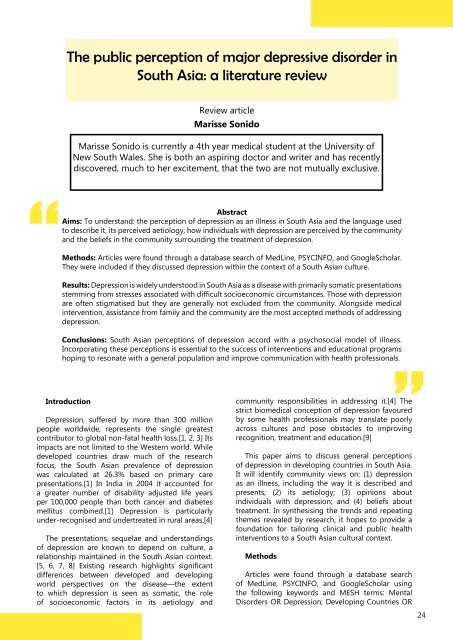Vector Volume 12 Issue 2 - 2018
Create successful ePaper yourself
Turn your PDF publications into a flip-book with our unique Google optimized e-Paper software.
The public perception of major depressive disorder in<br />
South Asia: a literature review<br />
Review article<br />
Marisse Sonido<br />
Marisse Sonido is currently a 4th year medical student at the University of<br />
New South Wales. She is both an aspiring doctor and writer and has recently<br />
discovered, much to her excitement, that the two are not mutually exclusive.<br />
“<br />
Abstract<br />
Aims: To understand: the perception of depression as an illness in South Asia and the language used<br />
to describe it, its perceived aetiology, how individuals with depression are perceived by the community<br />
and the beliefs in the community surrounding the treatment of depression.<br />
Methods: Articles were found through a database search of MedLine, PSYCINFO, and GoogleScholar.<br />
They were included if they discussed depression within the context of a South Asian culture.<br />
Results: Depression is widely understood in South Asia as a disease with primarily somatic presentations<br />
stemming from stresses associated with difficult socioeconomic circumstances. Those with depression<br />
are often stigmatised but they are generally not excluded from the community. Alongside medical<br />
intervention, assistance from family and the community are the most accepted methods of addressing<br />
depression.<br />
Conclusions: South Asian perceptions of depression accord with a psychosocial model of illness.<br />
Incorporating these perceptions is essential to the success of interventions and educational programs<br />
hoping to resonate with a general population and improve communication with health professionals.<br />
Introduction<br />
Depression, suffered by more than 300 million<br />
people worldwide, represents the single greatest<br />
contributor to global non-fatal health loss.[1, 2, 3] Its<br />
impacts are not limited to the Western world. While<br />
developed countries draw much of the research<br />
focus, the South Asian prevalence of depression<br />
was calculated at 26.3% based on primary care<br />
presentations.[1] In India in 2004 it accounted for<br />
a greater number of disability adjusted life years<br />
per 100,000 people than both cancer and diabetes<br />
mellitus combined.[1] Depression is particularly<br />
under-recognised and undertreated in rural areas.[4]<br />
The presentations, sequelae and understandings<br />
of depression are known to depend on culture, a<br />
relationship maintained in the South Asian context.<br />
[5, 6, 7, 8] Existing research highlights significant<br />
differences between developed and developing<br />
world perspectives on the disease—the extent<br />
to which depression is seen as somatic, the role<br />
of socioeconomic factors in its aetiology and<br />
community responsibilities in addressing it.[4] The<br />
strict biomedical conception of depression favoured<br />
by some health professionals may translate poorly<br />
across cultures and pose obstacles to improving<br />
recognition, treatment and education.[9]<br />
This paper aims to discuss general perceptions<br />
of depression in developing countries in South Asia.<br />
It will identify community views on: (1) depression<br />
as an illness, including the way it is described and<br />
presents; (2) its aetiology; (3) opinions about<br />
individuals with depression; and (4) beliefs about<br />
treatment. In synthesising the trends and repeating<br />
themes revealed by research, it hopes to provide a<br />
foundation for tailoring clinical and public health<br />
interventions to a South Asian cultural context.<br />
Methods<br />
”<br />
Articles were found through a database search<br />
of MedLine, PSYCINFO, and GoogleScholar using<br />
the following keywords and MESH terms: Mental<br />
Disorders OR Depression; Developing Countries OR<br />
24

















